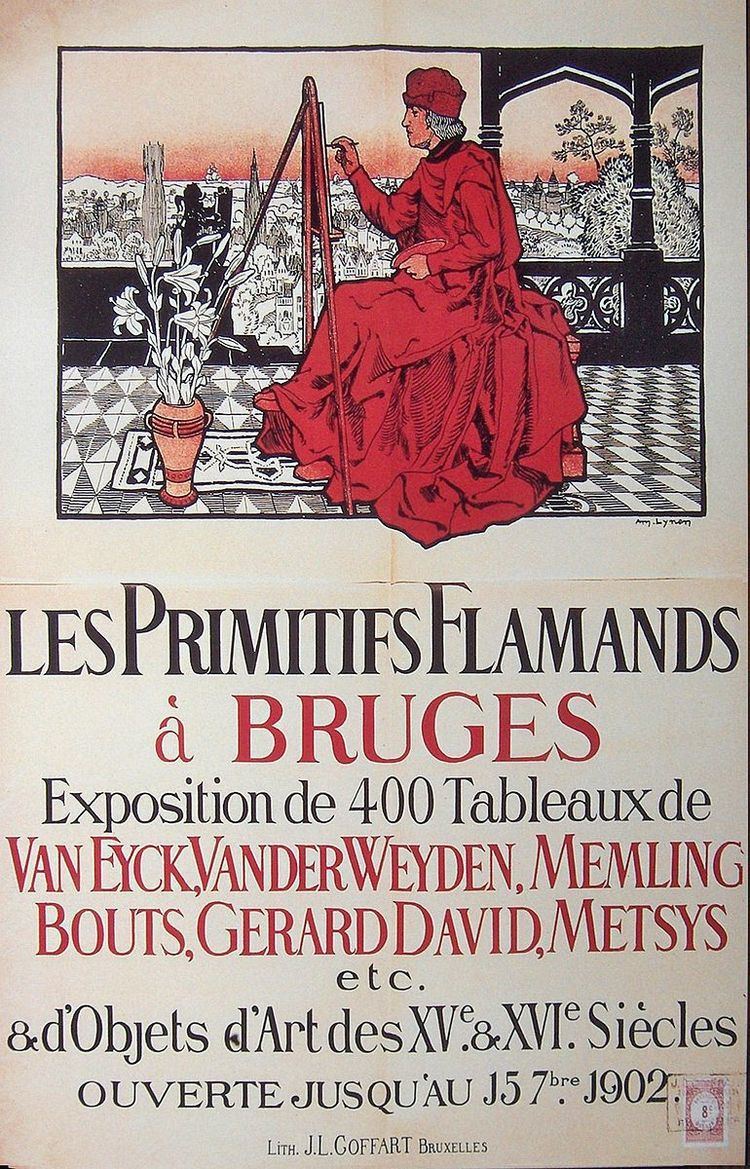 | ||
The Exposition des primitifs flamands à Bruges (Exhibition of Flemish Primitives at Bruges) was an art exhibition of paintings by the so-called Flemish Primitives (nowadays usually called Early Netherlandish painters) held in the Provinciaal Hof in Bruges between 15 June and 5 October 1902.
Contents
It was the largest exhibition of c 15th c Flemish art to date, consisted of 413 official catalogue entries, and drew some 35,000 visitors. The exposition was highly influential, leading to at least five contemporary books as well as numerous scholarly articles, and initiated deeper study of the Flemish Primitives by a new generation of connoisseurs. It also inspired Johan Huizinga to research and write his The Autumn of the Middle Ages. The change in attribution of many important works (in table below) reflects progress in understanding the era by art historians since then, although it is an ongoing process.
Exposition
The 1902 exhibition was not the first to focus on the Flemish Primitives, although it was the first on this scale and to generate so much interest and scientific feedback. Among earlier exhibitions were the 1867 "Tableaux de l'ancienne école Néerlandaise" in Bruges, also directed by W. H. J. Weale; the 1892 "Exhibition of pictures by masters of the Netherlandish and allied schools of XV and early XVI centuries" at the Burlington Fine Arts Club, with 60 pictures; and the 1899 Netherlandish School exhibition at the New Gallery (London), with 165 works.
The 1902 exposition was originally intended for Brussels, but moved to Bruges after the city refused to lend the many works it held to the exhibition if it did not take place in Bruges. It was held in the Provincial Government Palace in Bruges from 15 June until 15 September 1902, but due to popular demand was extended until 5 October 1902.
The president of the exhibition was Baron Henri Kervyn de Lettenhove.
William Henry James Weale wrote the notes for the catalogue for the painting section. The often erroneous attributions were those of the owners, but the position of the paintings in the exhibition generally reflected the opinion of the organizers, including Weale and Georges Hulin de Loo (a professor at the University of Ghent), regarding their authorship. The illustrated catalogue of the section showing manuscripts, miniatures, archive texts, seals, mereaux, coins and medals was written by Baron Albert Van Zuylen Van Nyevelt. A third section, covering needlework, gobelins, and the like, was catalogued by Isabelle Errera.
The exhibition showed some 400 paintings attributed to the Flemish Primitives, many of which had never before been exhibited. The display of many works by major artists created the first strong opportunity to compare their styles side by side and revise earlier attributions, either from one painter to another or from "work by" to "copy of a work by".
The exhibition was opened by King Leopold II of Belgium, and visited by Crown Prince Albert and Crown Princess Elisabeth on 3 July 1902.
Legacy
The exhibition showed far more of the most important remaining examples of Early Netherlandish panel painting than earlier exhibitions and sparked a lively discussion about the attributions of the paintings, started by Hulin de Loo: dissatisfied with the official catalogue, he published his own critical catalogue.
The exhibition greatly improved the appreciation of Early Netherlandish art, which previously had been chiefly appreciated only by a few collectors and art historians, but also led to shifts in the status of the artists: Hans Memling, who had been considered to be the major artist of the period, was surpassed by the likes of Jan van Eyck and Rogier van der Weyden. This has been attributed to the abundance of works by Memling at the exhibition, which made critics notice the lack of invention and overly serialized production he often showed, compared to the other masters.
Because the organizers of the exhibition had a somewhat Belgian nationalistic view, art lovers in other countries sometimes reacted vehemently to the appropriation of "their" painters by the Flemish or Belgians. In France, there were calls for a similar exhibition of French Primitives, which was organised in 1904 and tried to reclaim artists, like van der Weyden and Robert Campin, who were from French-speaking parts of the Netherlands; it also tried to cast Early Netherlandish painting as a derivative of Early French painting.
The Bruges exhibition directly influenced some painters, who incorporated aspects of Flemish Primitive painting into their work. Flemish expressionist Gustave Van de Woestijne changed his approach to portraiture, focusing more on the psychological aspects, while his colleague Valerius de Saedeleer was influenced by the landscapes he saw at the exhibition.
In 2002, a new exhibition documenting the 1902 exhibition and its impact was held in Bruges: "Impact 1902 Revisited. Early Flemish and Ancient Art exhibition. Bruges 15th June - 15th September 1902, Brugge, 2002.", with a catalogue by Eva Tahon, Piet Boyens e.a.
Publications
Apart from the official catalogue, a number of books and major articles were written about the exhibition, including:
Exhibited works
The works are listed according to their current attributions; where known, the attributions as given by the official catalogue and the critical catalogue by Hulin de Loo are given as well.
